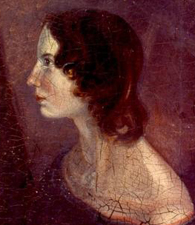“Emily Brontë wrote so little in her short life that it is difficult to appraise her work…One point is generally agreed upon: that in both her prose and poetry there is…a rare power,” said British poetry scholar Paul Lieder. Tuberculosis claimed her at age 30, but her sole novel, “Wuthering Heights,” and single volume of poetry made Emily Brontë an integral member of the Western literary canon.
Emily Brontë’s Early Days
Emily Jane Brontë was born on July 30, 1818, in a small town in rural Yorkshire. Shortly thereafter, her family moved to the Haworth parsonage on the Yorkshire moors. Her mother died when she was only 3 years old.
As a young girl, she attended boarding school for six months, but two of her sisters became extremely ill there, so all the siblings returned home. The two sick children died, and Brontë, along with her sisters Charlotte and Anne, and brother Branwell, continued her learning at home.
According to the Cambridge Guide to Literature in English, “The girls’ real education, however, was at the Haworth parsonage, where they had the run of their father’s books, and were thus nurtured on the Bible, Homer, Virgil, Shakespeare, Milton, Byron, Sir Walter Scott and many others.”
Later, Brontë taught school and worked as a governess; she and her sisters also tried and failed to open a school. However, they each managed to produce a novel. Some credit the girls’ unruly and unconventional upbringing with providing the fodder for their imaginations and subsequent great works of fiction.
Brontë Country, a Web site devoted to where the Brontës lived and worked, offers photos of the Brontë Birthplace and the Haworth parsonage, now the Brontë Parsonage Museum. The surrounding area between West Yorkshire and East Lancashire Pennines, where the Brontë siblings were raised, is “a windswept land of heather and wild moors” and “it is hardly surprising that this region became the inspiration for the classic works of the Brontë sisters, Charlotte, Emily and Anne.”
“Early biographers and critics sometimes assumed that the Brontës based their fiction exclusively on real life places, people and events, perhaps unwilling to accept that the daughters of a clergyman could produce what were often perceived as shocking, amoral books,” notes the Brontë Parsonage Museum site.
However, the more likely explanation is that the girls had the gift of highly vivid imaginations. The sisters lived at a peculiar crossroads of Victorian society: well educated, which made them socially elevated, but outside the norm, because they worked for a living and lacked the common accoutrements of wealth.
Sources in this Story
- The Victorian Web: Emily Jane Brontë: Poet and Novelist (1818-48)
- The Brontë Parsonage Museum: Introduction to the Novels
- University of Pennsylvania Digital Library Projects: Poems by Currer, Ellis, and Acton Bell
- Encyclopedia Britannica: Emily Brontë
- CUNY Brooklyn: Publication of Wuthering Heights and Its Contemporary Critical Reception
- Poets’ Graves: Emily Brontë
Brontë’s “Wuthering Heights”
The Brontë sisters began their writing career using gender-neutral pseudonyms: Currer (Charlotte), Ellis (Emily), and Acton (Anne) Bell. They published a volume of poetry together, titled “Poems by Currer, Ellis, and Acton Bell,” in 1846, but only two copies were sold. According to literary scholar Joyce M.S. Tompkins, “a consensus of later criticism has accepted the fact that Emily’s verse alone reveals true poetic genius.”
The following year, three of the sisters’ novels were published, all under their pseudonyms: Charlotte’s “Jane Eyre.” Anne’s “Agnes Grey,” and Emily’s “Wuthering Heights.”
Using a complex narrative structure, “Wuthering Heights” tells the story of Heathcliff Earnshaw, an adopted child who was mistreated by his adopted brother and who passionately loved his adopted sister Catherine. Devastated when Catherine marries Edgar Linton, he plots to destroy the lives of his siblings, the Linton family, and their descendants.
“What is exceptional for the period is the absence of explicit condemnation by Emily of Heathcliff’s conduct, or any suggestion that evil might bring its own punishment,” writes the Brontë Parsonage Museum. “The novel is morally ambiguous, the author leaving us to draw our own conclusions.”
The “sombre power of the book and the elements of brutality in the characters affronted some 19th-century opinion,” writes Tompkins, and it received mixed reviews when it was published. Critics praised Brontë’s powerful writing, but thought that the novel needed to be more refined.
The 1848 edition of Atlas wrote: “Wuthering Heights is a strange, inartistic story. There are evidences in every chapter of a sort of rugged power—an unconscious strength—which the possessor seems never to think of turning to the best advantage. The general effect is inexpressibly painful. We know nothing in the whole range of our fictitious literature which presents such shocking pictures of the worst forms of humanity…The work of Currer Bell is a great performance; that of Ellis Bell is only a promise, but it is a colossal one.”
The Rest of the Story
Only a year after publishing “Wuthering Heights,” Brontë caught a cold while attending her brother Branwell’s funeral. Her illness quickly became tuberculosis, and she died on December 19, 1848. She is buried in the Brontë family vault at St. Michael and All Angels’ Church in Haworth, Yorkshire.
This article was originally written by Rachel Balik; it was updated June 27, 2017.











